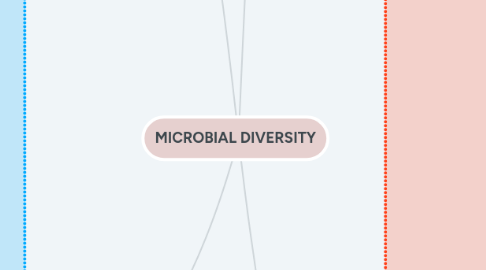
1. ARCHAE
1.1. Crenaracheota
1.1.1. most are extremely thermophilic
1.1.2. strict anaerobs
1.1.3. some are acidophiles
1.1.4. sulfer-dependent
1.1.4.1. organotrophs
1.1.4.2. lithotrophs
1.2. Thaumarchaeota
1.2.1. membrane lipids
1.2.1.1. crenarcheol
1.2.1.2. crenarcheol
1.2.2. mesophilic archea
1.2.2.1. nitrification
1.3. Euryachaeota
1.3.1. methogens and methanogenesis
1.3.1.1. produce methane
1.3.1.2. important in wastewater treatment
1.3.1.3. oxidize iron
1.3.1.4. from symbiotic relationships with certain bacteria
1.3.2. halobacteria
1.3.2.1. extreme halophiles
1.3.2.1.1. require at least 1.5 M NaCl
1.3.2.2. aerobic
1.3.2.2.1. possess some methanogen coenzymes
1.3.2.3. chemoheterotrophs
1.3.2.4. complex nutritional requirement
1.3.3. thermoplasms
1.3.3.1. thermoacidophiles
1.3.3.2. lack cell walls
1.3.4. extremely thermophilic S- metabolizers
1.3.4.1. motile by flagella
1.3.4.2. optimum growth temperature 88-100C
1.3.4.3. strictly anaerobic
1.3.4.4. reduce sulfur to sulfide
1.3.5. sulfate-reducers
1.3.5.1. irregular coccoid cells
1.3.5.1.1. glycoprotein subunits
1.3.5.2. extremely themophilic
1.3.5.3. metbolism
1.3.5.3.1. lithotrophic or organotrophic
1.3.5.3.2. use sulfate, sulfite, or thiosulfite as electron acceptor
2. BACTERIA
2.1. Aquificae
2.1.1. oldest branch
2.1.2. thermophiles
2.2. Thermotogae
2.2.1. second deepest branch
2.2.2. gram-negative rods
2.2.3. Thermophiles
2.2.4. chemoheterophs
2.3. Deinococcus-Thermus
2.3.1. spherical or rod-shaped
2.3.2. in pairs or tetrad
2.3.3. gram-positive (lack typical Gram-positive cell wall)
2.3.4. aerobic
2.3.5. extraordinarily resistant to desiccation and radiation
2.3.6. from ground meat, feces, air, fresh water
2.4. Photosynthesis bacteria
2.4.1. Chlorobi
2.4.1.1. green-sulphur bacteria
2.4.1.2. thrive sulfide rich areas
2.4.1.3. chlorosomes
2.4.1.3.1. ellipsoidal vesicles attached to plasma membrane
2.4.1.3.2. efficient light harvesting complexes
2.4.1.4. lnon motile
2.4.1.5. have gas vesicles
2.4.1.6. obligate anerobic photolithoautotrophs
2.4.2. Chloroflexi
2.4.2.1. green non sulphur
2.4.2.2. both photosynthetic and non photosynthetic
2.4.2.3. filamentous
2.4.2.4. thermophilic
2.4.2.5. anoxygenic photosynthesis
2.4.3. Cyanobacteria
2.4.3.1. largest group
2.4.3.2. gram-negative
2.4.3.3. obligate photolithoautotrophs
2.4.3.4. storage structures
2.4.3.4.1. carboxysomes
2.4.3.4.2. cyanophycin
2.4.3.5. unicellular, colonial, filament (trichomes)
2.4.3.6. carbon fixation
2.4.3.6.1. use phycobiliproteins as acessory pigments
2.4.3.6.2. calvin cycle
2.4.3.7. pigmentation
2.4.3.7.1. blue green
2.4.3.7.2. red or brown
2.4.4. Planctomycetes
2.4.4.1. anammoxomes compartment
2.4.4.2. lacks of peptidoglycans
2.4.5. Chlamydiae
2.4.5.1. gram-negative
2.4.5.2. obligate intracellular parasites
2.4.6. Spirochaetes
2.4.6.1. gram-negative
2.4.6.2. chemoheterotrophic bacteria
2.4.6.3. oxygen requirement vary
2.4.6.4. free living
2.4.6.5. symbiotic
2.4.6.5.1. hindguts of termites
2.4.6.5.2. digestive tracts of mollusks and mammals
2.4.6.5.3. oral cavities of animals
2.4.7. Bacteroidetes
2.4.7.1. Bacteroids
2.4.7.1.1. anerobic
2.4.7.1.2. gram -
2.4.7.1.3. various shape
2.4.7.1.4. chemoheterophs - fermentive
2.4.8. proteobacterium
2.4.8.1. single photosynthetic ancestor
2.4.8.2. Alphaproteobacterium
2.4.8.3. Betaproteobacterium
2.4.8.4. Gammaproteobacterium
2.4.8.4.1. largest bacterial clss
2.4.8.4.2. diverse physiological type
2.4.8.5. Deltaproteobacterium
2.4.8.6. Epsilonproteobacterium
2.4.8.6.1. smallest class
2.4.8.6.2. slender gram negative rod
2.4.8.6.3. ranges from pathogens to deep-sea bacteria
2.4.9. Firmicutes
2.4.9.1. low G + C Gram positive bacteria
2.4.9.2. 3 classes
2.4.9.2.1. Clostridia
2.4.9.2.2. Bacilli
2.4.9.2.3. Negativicutes
2.4.10. Actinobacteria
2.4.10.1. high G + C gram positive
2.4.10.2. aerobic
2.4.10.3. filamentous cell called hyphae
2.4.10.4. adapt climate similar fungi
2.4.10.5. source most currectly used antibiotics
2.4.10.6. produce metabolites anticancer, antihelminthic, immunosuppressive
3. FUNGI
3.1. Ascomycota
3.1.1. found in freshwater, marine and terrestrial habitat
3.1.2. can cause food spoilage
3.1.3. some plant and human pathogens
3.1.4. genus : Aspergillus
3.2. Basidiomycota
3.2.1. club fungi
3.2.2. decomposer
3.3. Glomeromycota
3.3.1. aseptate flat hyphae (appressoria)
3.3.2. as mycorrhizal symbionts of vascular plants
3.4. Zygomycota
3.4.1. saprophytes
3.4.2. coenocytic hyphae
3.4.3. reproduce asexually by spores
3.4.4. sexual reproductio occure when environmental conditios are not favorable
3.4.5. Rhizopus
3.4.5.1. rhizopus - burkholderia symbiosis
3.4.5.2. used to produce tempeh
3.4.5.3. used with soybean
3.5. Microsporidia
3.5.1. intracellular fungal parasite that infect insects, fish,human
3.5.2. spore structure capable of surviving outside host
4. PROTISTS
4.1. Excavata
4.1.1. Fornicata
4.1.1.1. Microaerophilic protist
4.1.1.2. most are harmless symbiots
4.1.1.3. Giardia - cause diarrhea
4.1.2. Parabasilia
4.1.2.1. most flagellated endosymbionts
4.1.2.2. lacks of distict cytostome, use phagocytosis to engulf food
4.1.2.3. Trichonymphida
4.1.2.3.1. obligate mutuals of wood-eating insects
4.1.2.3.2. release cellulose for digesting
4.1.2.3.3. ecdysone hormone - triggers sexual reproduction
4.1.2.4. Trichomonadida
4.1.2.4.1. not require oxygen
4.1.2.4.2. posses hydrogenesosomes
4.1.2.4.3. asexual reproduction only
4.1.2.4.4. symbionts relatioships
4.1.3. Euglenozoa
4.1.3.1. found in fresh water
4.1.3.2. 1/3 photoautotrophic rest are chemoorganotrophs
4.2. Amoebozoa
4.2.1. amoeboid motility
4.2.1.1. lobopodia - round
4.2.1.2. filopodia - long and narrow
4.2.1.3. reticulopodia - form a netlike mesh
4.2.2. naked amoeba - surround only plasma membrane
4.2.3. binary or multiple fission
4.3. Rhizaria
4.3.1. Stramenopila
4.3.1.1. diatoms
4.3.1.2. golden and brown algae
4.3.1.3. oomycetes and labyrinthulids
4.3.1.4. haptophytes
4.3.1.5. brown seaweeds and kelp
4.3.2. Alveolata
4.3.2.1. Apicomplexa
4.3.2.1.1. unipolar apical complex
4.3.2.1.2. complex life cycles
4.3.2.2. Dinoflagellata
4.3.2.2.1. large group in marine plankton
4.3.2.2.2. nutrionally complex
4.3.2.2.3. trichocyst - defensive proteins
4.3.2.3. Ciliphora
4.3.2.3.1. chemoorganotrophic
4.3.2.3.2. found in bethic and planktonic communities in water and soil system
4.3.2.3.3. many cilia as locomotory and feeding organelles
4.4. Archaeplastida
4.4.1. containing a photosynthetic plastid
